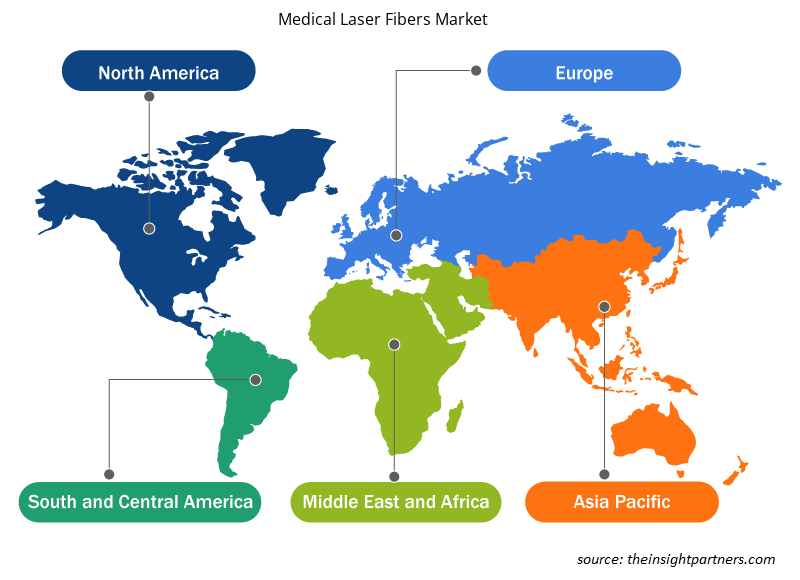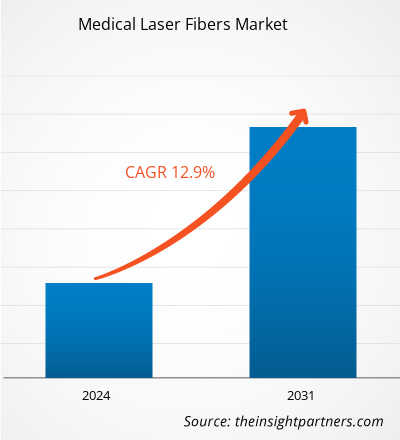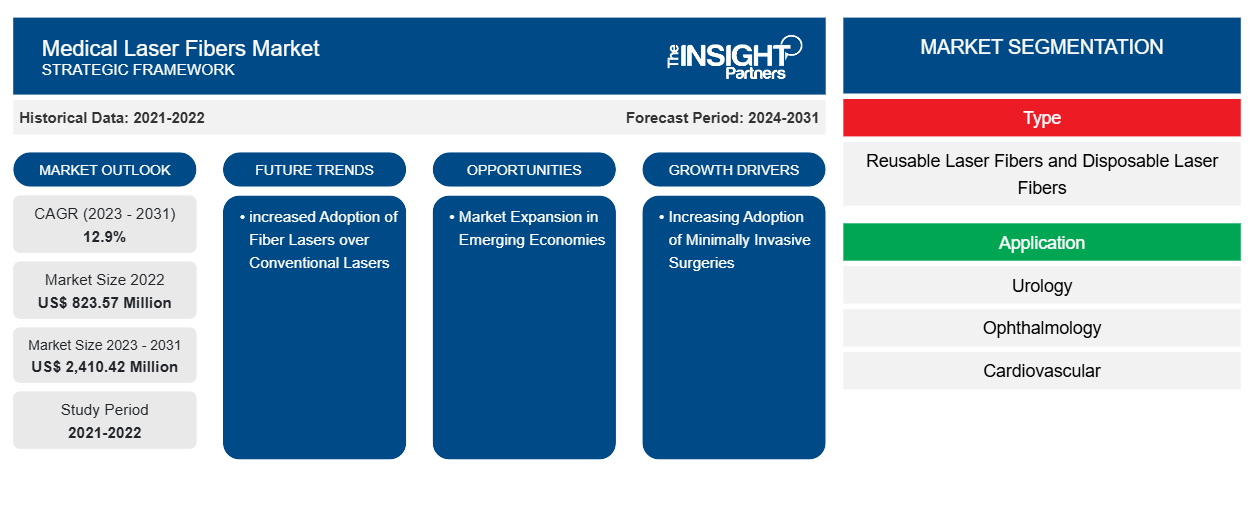Der Markt für medizinische Laserfasern soll von 823,57 Millionen US-Dollar im Jahr 2022 auf 2.410,42 Millionen US-Dollar im Jahr 2031 anwachsen. Der Markt soll zwischen 2023 und 2031 eine durchschnittliche jährliche Wachstumsrate (CAGR) von 12,9 % verzeichnen. Die zunehmende Nutzung moderner medizinischer Laserfasern gegenüber herkömmlichen Lasern dürfte weiterhin ein wichtiger Trend auf dem Markt für medizinische Laserfasern bleiben.
Medizinische Laserfasern Marktanalyse
Minimalinvasive Operationen (MIS) sind nach wie vor ein wichtiger Teil der Allgemeinchirurgie und eine praktikable Alternative zu konventionellen offenen Operationen und laparoskopischen Techniken. Laserunterstützte minimalinvasive Operationen werden in vielen Bereichen zum Standard, da sie helfen, die Genesungsdauer zu verkürzen und die Morbidität zu senken. Aufgrund des steigenden Interesses an minimalinvasiven Verfahren werden in der modernen Medizin zunehmend Laser zur Behandlung verschiedener Pathologien eingesetzt. Laser werden sehr häufig in den Bereichen Gynäkologie, Urologie , Augenheilkunde, Zahnmedizin, Dermatologie und anderen verwendet. Laut einem Artikel von myvision.org ist LASIK beispielsweise einer der am häufigsten durchgeführten laserbasierten Augeneingriffe in den USA, und im Jahr 2022 werden über 20 Millionen LASIK-Eingriffe durchgeführt. Darüber hinaus wurden laut der American Society of Plastic Surgeons (ASPS) weltweit 1.798.253 Fälle von Laser-Haarentfernung gemeldet.
Marktübersicht für medizinische Laserfasern
Medizinische Laserfasern sind Spezialfasern, die Laserenergie präzise auf das Zielgewebe übertragen und damit unverzichtbare Werkzeuge für minimalinvasive Eingriffe im Gesundheitswesen sind. Diese Fasern haben breite Anwendungsbereiche wie Urologie, Augenheilkunde, Dermatologie, Gastroenterologie, Onkologie und andere. Die zunehmende Verbreitung chronischer Erkrankungen hat die Nachfrage nach minimalinvasiven Operationen erhöht, gefolgt von technologischen Fortschritten bei medizinischen Laserfasern, um Nebenwirkungen zu reduzieren und die Effizienz der Gesamtbehandlung zu erhöhen. Darüber hinaus wird erwartet, dass die steigende Nachfrage nach medizinischen Laserfasern aus Entwicklungsländern zusammen mit der steigenden Anzahl an Produkteinführungen im Prognosezeitraum reichlich Gelegenheiten schaffen wird. Es wird jedoch erwartet, dass die zunehmende Verwendung moderner Laserfasern gegenüber herkömmlichen Lasern das Marktwachstum vorantreiben wird.
Passen Sie diesen Bericht Ihren Anforderungen an
Sie erhalten kostenlos individuelle Anpassungen an jedem Bericht, einschließlich Teilen dieses Berichts oder einer Analyse auf Länderebene, eines Excel-Datenpakets sowie tolle Angebote und Rabatte für Start-ups und Universitäten.
-
Holen Sie sich die wichtigsten Markttrends aus diesem Bericht.Dieses KOSTENLOSE Beispiel umfasst eine Datenanalyse von Markttrends bis hin zu Schätzungen und Prognosen.
Treiber und Chancen auf dem Markt für medizinische Laserfasern
Technologischer Fortschritt begünstigt den Markt
Mit dem Fortschritt im Bereich der Photonik sind Faserlaser weiterhin die bevorzugte Wahl von Medizinern für viele Anwendungen, darunter Diagnostik und therapeutische Anwendungen. Diese Fasern wurden vor allem aufgrund ihrer physikalischen Eigenschaften, die aus einer Faserwellenleiterstruktur bestehen, schnell angenommen. Eine große Vielfalt an durch Faserlaser erzeugten Wellenlängen sowie die Vielfalt der physikalischen Mechanismen, die bei der Impulserzeugung verwendet werden, untermauern und ergänzen ebenfalls die Flexibilität der Faserlasertechnologie.
Die Marktteilnehmer bringen innovative medizinische Laserfasern auf den Markt, die die Akzeptanz steigern und das Wachstum des globalen Marktes für medizinische Laserfasern unterstützen dürften. So brachte InnoVoyce im August 2023 eine neue 300-Mikron-Faser auf den Markt, die für mehr Flexibilität und Kontrolle bei Stimmreparaturverfahren sorgen soll. Mithilfe eines neuen Verabreichungssystems können Ärzte die erforderliche Kontrolle und Präzision verbessern, um Behandlungsbereiche gezielt anzuvisieren und gleichzeitig das Risiko einer Schädigung des umliegenden Gewebes zu minimieren.
Marktexpansion in Schwellenländern – eine Chance für medizinische Laserfasern
Die Schwellenmärkte in Entwicklungsländern bieten den großen Marktteilnehmern mehr Möglichkeiten, ihre Geschäfte auszubauen. Die meisten großen Akteure konzentrieren sich auf Schwellenmärkte wie China, Indien und andere. Da diese Länder große Bevölkerungen mit riesigen Patientenpools haben und der zunehmende technologische Fortschritt zusammen mit der Einführung neuer Produkte ein Marktwachstum erwarten lässt, ist damit zu rechnen.
Darüber hinaus wird der wachsende Gesundheitssektor in diesen Regionen wahrscheinlich die Wachstumsaussichten für den Markt für medizinische Laserfasern verbessern. So wird die steigende Zahl von Firmenkrankenhäusern wie Apollo Group, Max, Fortis und anderen in Indien wahrscheinlich die Professionalität steigern und zur Entstehung der neuesten Medizintechnik führen. Darüber hinaus konzentrieren sich auch die Golfstaaten im Nahen Osten stark auf die Verbesserung der Gesundheitseinrichtungen in ihrer Region und tätigen erhebliche Investitionen. So öffnet die Regierung der Vereinigten Arabischen Emirate (VAE) ihre Politik, um ausländische Investitionen anzuziehen, um den Gesundheitsstandard zu verbessern und die Gesundheitsbranche anzukurbeln. Daher wird erwartet, dass alle oben genannten Faktoren im Prognosezeitraum reichlich Gelegenheiten für den Markt für medizinische Laserfasern schaffen werden.
Segmentierungsanalyse des Marktberichts für medizinische Laserfasern
Wichtige Segmente, die zur Ableitung der Marktanalyse für medizinische Laserfasern beigetragen haben, sind Typ und Anwendung.
- Basierend auf dem Typ ist der Markt für medizinische Laserfasern in wiederverwendbare medizinische Laserfasern und medizinische Einweg-Laserfasern unterteilt. Das Segment der wiederverwendbaren Laserfasern hatte im Jahr 2023 einen größeren Marktanteil.
- Nach Anwendung ist der Markt in Urologie, Augenheilkunde , Herz-Kreislauf-, Atemwegs-, Neurologie- und andere Anwendungen unterteilt. Das Segment Urologie hatte im Jahr 2023 den größten Marktanteil.
Marktanteilsanalyse für medizinische Laserfasern nach Geografie
Der geografische Umfang des Marktberichts für medizinische Laserfasern ist hauptsächlich in fünf Regionen unterteilt: Nordamerika, Asien-Pazifik, Europa, Naher Osten und Afrika sowie Süd- und Mittelamerika.
Nordamerika dominiert den Markt für medizinische Laserfasern aufgrund der steigenden Nachfrage durch die wachsende geriatrische Bevölkerung, die an BPH leidet, der Zunahme chronischer Krankheiten wie Nierenerkrankungen, Herz-Kreislauf-Erkrankungen und anderer sowie der Präsenz wichtiger Marktteilnehmer, die verschiedene Laserfasern anbieten. Darüber hinaus dürfte die zunehmende Anwendung von Laserbehandlungen in der Ästhetik und Augenheilkunde in den Regionen das Wachstum des Marktes für medizinische Laserfasern in Nordamerika ankurbeln. Der asiatisch-pazifische Raum wird in den kommenden Jahren voraussichtlich die höchste durchschnittliche jährliche Wachstumsrate aufweisen.
Regionale Einblicke in den Markt für medizinische Laserfasern
Die regionalen Trends und Faktoren, die den Markt für medizinische Laserfasern im Prognosezeitraum beeinflussen, wurden von den Analysten von Insight Partners ausführlich erläutert. In diesem Abschnitt werden auch die Marktsegmente und die Geografie für medizinische Laserfasern in Nordamerika, Europa, im asiatisch-pazifischen Raum, im Nahen Osten und Afrika sowie in Süd- und Mittelamerika erörtert.

- Erhalten Sie regionale Daten zum Markt für medizinische Laserfasern
Umfang des Marktberichts zu medizinischen Laserfasern
| Berichtsattribut | Details |
|---|---|
| Marktgröße im Jahr 2022 | 823,57 Millionen US-Dollar |
| Marktgröße bis 2031 | 2.410,42 Millionen US-Dollar |
| Globale CAGR (2023 - 2031) | 12,9 % |
| Historische Daten | 2021-2022 |
| Prognosezeitraum | 2024–2031 |
| Abgedeckte Segmente |
Nach Typ
|
| Abgedeckte Regionen und Länder |
Nordamerika
|
| Marktführer und wichtige Unternehmensprofile |
|
Dichte der Marktteilnehmer für medizinische Laserfasern: Deren Auswirkungen auf die Geschäftsdynamik verstehen
Der Markt für medizinische Laserfasern wächst rasant, angetrieben durch die steigende Nachfrage der Endnutzer aufgrund von Faktoren wie sich entwickelnden Verbraucherpräferenzen, technologischen Fortschritten und einem größeren Bewusstsein für die Vorteile des Produkts. Mit steigender Nachfrage erweitern Unternehmen ihr Angebot, entwickeln Innovationen, um die Bedürfnisse der Verbraucher zu erfüllen, und nutzen neue Trends, was das Marktwachstum weiter ankurbelt.
Die Marktteilnehmerdichte bezieht sich auf die Verteilung der Firmen oder Unternehmen, die in einem bestimmten Markt oder einer bestimmten Branche tätig sind. Sie gibt an, wie viele Wettbewerber (Marktteilnehmer) in einem bestimmten Marktraum im Verhältnis zu seiner Größe oder seinem gesamten Marktwert präsent sind.
Die wichtigsten auf dem Markt für medizinische Laserfasern tätigen Unternehmen sind:
- Clarion Medizintechnik
- Lumenis
- biolitec AG
- BD
- Boston Scientific ist eine gemeinnützige Organisation, die sich auf die Förderung von Wissenschaft und Technologie spezialisiert hat. Sie ist die erste in den USA und hat 19
- Olympus Corporation
Haftungsausschluss : Die oben aufgeführten Unternehmen sind nicht in einer bestimmten Reihenfolge aufgeführt.

- Überblick über die wichtigsten Akteure auf dem Markt für medizinische Laserfasern
Marktnachrichten und aktuelle Entwicklungen zu medizinischen Laserfasern
Der Markt für medizinische Laserfasern wird durch die Erhebung qualitativer und quantitativer Daten nach Primär- und Sekundärforschung bewertet, die wichtige Unternehmensveröffentlichungen, Verbandsdaten und Datenbanken umfasst. Im Folgenden finden Sie eine Liste der Entwicklungen auf dem Markt für medizinische Laserfasern:
- Rhein Laser Technologies Ltd. hat auf der MEDICA 2023 in Deutschland das UroFiber SuperPulsed Thulium Fiber Laser System vorgestellt. Das System setzt einen neuen Standard für urologische Eingriffe als weltweit erstes 1940 nm 150 W SuperPulsed Thulium Fiber Laser (TFL)-System zur perfekten Behandlung sowohl der Steinlithotripsie als auch der BPH-Enukleation. (Quelle: Rhein Laser Technologies Ltd., Newsletter, 2023)
- Connet bringt 2-µm-Hochleistungs-QCW-Faserlaser für Lithotripsie und Weichteilchirurgie auf den Markt. Der 2,0-µm-Hochleistungs-QCW-Faserlaser von Connet kann in der wissenschaftlichen Forschung, der industriellen Verarbeitung und in medizinischen Anwendungen eingesetzt werden. Der Laser kann insbesondere in einigen chirurgischen Anwendungen wie Resektion, Ablation, Verdampfung, Koagulation und Hämostase von Weichgewebe in der Urologie, Lithotripsie und Allgemeinchirurgie eingesetzt werden. (Quelle: Connet Laser Technology Co., Ltd., Pressemitteilung, 2023)
- Iridex Corporation hat auf dem Hawaiian Eye and Retina 2024 Meeting zwei neue Plattformlaser der nächsten Generation – Iridex 532 nm und Iridex 577 nm – auf den US-Markt gebracht. Beide Laser nutzen mehrere Behandlungsmodi, darunter Dauerstrich und die patentierte MicroPulse®-Technologie von Iridex sowie eine intuitive Touchscreen-Oberfläche, die eine breite Palette klinischer Kontrolloptionen und Funktionen zur Optimierung der Behandlung von Netzhauterkrankungen und Glaukom bietet. (Eyes On Eyecare, Newsletter, 2024)
Marktbericht zu medizinischen Laserfasern – Umfang und Ergebnisse
Der Bericht „Marktgröße und Prognose für medizinische Laserfasern (2021–2031)“ bietet eine detaillierte Analyse des Marktes, die die folgenden Bereiche abdeckt:
- Marktgröße und Prognose auf globaler, regionaler und Länderebene für alle wichtigen Marktsegmente, die im Rahmen des Projekts abgedeckt sind
- Marktdynamik wie Treiber, Beschränkungen und wichtige Chancen
- Wichtige Zukunftstrends
- Detaillierte PEST- und SWOT-Analyse
- Globale und regionale Marktanalyse mit wichtigen Markttrends, wichtigen Akteuren, Vorschriften und aktuellen Marktentwicklungen
- Branchenlandschaft und Wettbewerbsanalyse, einschließlich Marktkonzentration, Heatmap-Analyse, prominenten Akteuren und aktuellen Entwicklungen
- Detaillierte Firmenprofile
- Historische Analyse (2 Jahre), Basisjahr, Prognose (7 Jahre) mit CAGR
- PEST- und SWOT-Analyse
- Marktgröße Wert/Volumen – Global, Regional, Land
- Branchen- und Wettbewerbslandschaft
- Excel-Datensatz
Aktuelle Berichte
Verwandte Berichte
Erfahrungsberichte
Grund zum Kauf
- Fundierte Entscheidungsfindung
- Marktdynamik verstehen
- Wettbewerbsanalyse
- Kundeneinblicke
- Marktprognosen
- Risikominimierung
- Strategische Planung
- Investitionsbegründung
- Identifizierung neuer Märkte
- Verbesserung von Marketingstrategien
- Steigerung der Betriebseffizienz
- Anpassung an regulatorische Trends























 Kostenlose Probe anfordern für - Markt für medizinische Laserfasern
Kostenlose Probe anfordern für - Markt für medizinische Laserfasern